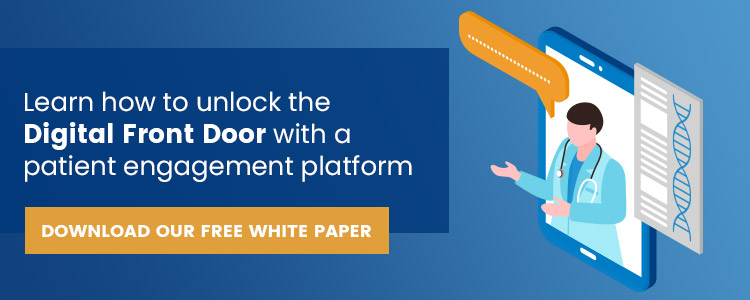Five Patient Engagement Ideas for Adapting to Consumer Healthcare Needs Now and Post-Pandemic
- Imogen Goodman
- October 27, 2021

The COVID pandemic has had a major impact on the needs of US healthcare consumers. Not only has it affected physical and mental health, but it has also impacted the way patients interact with their providers and what they prioritize for managing their care.
In a 2021 survey of US healthcare consumers, McKinsey found that patients were increasingly using digital tools for their health needs in the wake of the pandemic[¹]. While just 3% of patients reported that they had a telemedicine appointment in 2019, by February 2021, 24% reported that their most recent medical appointment had been conducted online[¹].
Unsurprisingly, patient safety concerns were a key reason for their changing behavior, with more than a third of patients saying they were willing to delay health appointments if they didn’t feel safe[²]going to their provider’s office.
On the provider side, healthcare practitioners have had to adapt to changing patient needs and expectations. In a 2020 consumer survey, 11% of respondents with a primary-care provider (PCP) said they wanted to switch providers due to a lack of communication around COVID, a lack of telemedicine appointments, or an insufficient response to the pandemic[²].
The pandemic will have lasting effects on US healthcare consumers. To meet the needs of patients in a post-pandemic world, providers must adapt. Healthcare organizations should aim to improve the patient experience for future growth by considering five key issues.
Providing holistic care
Mental health issues have accelerated since the pandemic and highlighted the strong link between social inequalities and healthcare outcomes.
In McKinsey’s survey, black and Latino respondents were less likely to say they were satisfied with their PCP, while people with more unmet social needs, stress, and sleep deficiency were far more likely to have visited an emergency room in the past year[³].
Providers can combat this by coordinating behavioral-, social-, and physical-healthcare services and offering better access points to social and behavioral services. It is essential that healthcare is targeted at the whole person, and that providers consider new patient engagement ideas that can reach those who currently feel unheard.
Communicate effectively
The US economy contracted by more than 19% in the early months of the COVID pandemic[⁴], and many households were directly hit by economic uncertainty and job losses. Accordingly, unforeseen healthcare costs were the second largest complaint patients had about their providers during COVID, with one in four patients surveyed by McKinsey saying they were “frustrated” by higher than expected healthcare bills[⁵].
If patients feel unable to predict the financial outlay involved in their treatments, this tends to correlate with a greater number of people postponing their healthcare appointments, which in turn has an impact on patient outcomes[⁵].
To give patients more certainty, payers should aim to be clear and transparent, incentivize patient research on healthcare services and costs, and share information with providers, who can then be up-front with their patient population about what costs to expect in the future.
Implement an effective patient engagement program
Evidence suggests that personalized patient engagement is key to helping patients avoid expensive unplanned follow-up care – particularly among less health-conscious patients[⁶]. More than one in four patients told McKinsey’s researchers that they felt unheard by their providers or had unmet administrative needs, like finding it hard to book appointments at a suitable time[³].
Providing patients with the tools they need to fit their healthcare around their lives, such as online scheduling and patient-provider messaging – and offering clear, accessible instructions for healthcare adherence – can help patients take control of their health both during and after the COVID pandemic.
Offer a seamless patient journey
With COVID driving a major transition to online and omnichannel healthcare services[⁷], patients increasingly expect user-friendly apps, portals, and websites to help them better manage their health and touchpoints along the care journey.
These digital tools are a crucial way of reaching out to patients as part of a cohesive patient engagement program. Providers should therefore ensure that their digital services and applications function as a coherent whole, are easy to navigate and have appropriate UI/UX design that facilitates both greater use and engagement.
Meet consumer demand for virtual health
Demand for virtual options at almost every stage of the patient journey has risen enormously in the past four or five years. As of 2020, 70-80% of Mckinsey’s respondents wanted to perform key aspects of their healthcare journey digitally, but the available options are failing to meet demand[³].
To combat this, a provider’s patient engagement program should include consumer-friendly digital tools that are tailored to the services patients value most. Patients should be given the flexibility and convenience of self-service features like appointment scheduling, bill pay, prescription refill requests, and patient-provider messaging – ideally through a single, easy-to-use digital platform.
A new approach is needed in order to meet changing healthcare consumer demands that have in part been driven by the pandemic. Focusing on holistic care, effective communications, personalized patient engagement, a seamless care journey, and continued emphasis on virtual health solutions can equip providers to handle these changes and ensure consumer satisfaction and loyalty now and post-pandemic.
- Charm, T., Hwang, J., Laird, J., Lu, N., Saavedra, J., Leon, A., Mazzara, D., Maiti, A., Robinson, K. and Skiles, T. (2021).US consumer sentiment and behaviors during the coronavirus crisis. [online] McKinsey. Available at: https://www.mckinsey.com/business-functions/marketing-and-sales/our-insights/survey-us-consumer-sentiment-during-the-coronavirus-crisis.
- Arora, N., Charm, T., Grimmelt, A., Ortega, M., Robinson, K., Sexauer, C., Staack, Y., Whitehead, S. and Yamakawa, N. (2020). A global view of how consumer behavior is changing amid COVID-19. [online] McKinsey. Available at: https://rb.gy/smtlmg.
- Cordina, J., Levin, E., Stein, G. (2021). COVID-19 Consumer Healthcare Insights: What 2021 may hold. [online] McKinsey. Available at: https://www.mckinsey.com/industries/healthcare-systems-and-services/our-insights/covid-19-consumer-healthcare-insights-what-2021-may-hold.
- Mutikani, L. (2021). U.S. economy contracted 19.2% during COVID-19 pandemic recession. [online] REUTERS. Available at: https://www.reuters.com/business/us-economy-contracted-192-during-covid-19-pandemic-recession-2021-07-29/.
- Cordnina, J., Greenberg, S. (2020). Consumer decision making in healthcare: The role of information transparency. [online] McKinsey. Available at: https://www.mckinsey.com/industries/healthcare-systems-and-services/our-insights/consumer-decision-making-in-healthcare-the-role-of-information-transparency.
- Cordina, J., Gilbert, G., Griffin, N., MPH, and Kumar, R. (2019). Next-generation member engagement during the care journey. [online] McKinsey. Available at: https://www.mckinsey.com/industries/healthcare-systems-and-services/our-insights/next-generation-member-engagement-during-the-care-journey.
- Bestsennyy, O., Gilbert, G., Harris, A. and Rost, J. (2021). Telehealth: A quarter-trillion-dollar post-COVID-19 reality?. [online] McKinsey. Available at: https://www.mckinsey.com/industries/healthcare-systems-and-services/our-insights/telehealth-a-quarter-trillion-dollar-post-covid-19-reality.
